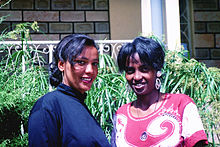
Back ইথিঅ’পিয়াৰ নাৰী Assamese زنان در اتیوپی Persian Condition des femmes en Éthiopie French Женщины в Эфиопии Russian ایتھوپیا وِچ زنانیاں SKR ایتھوپیا میں خواتین Urdu Efiopiyadagi ayollar Uzbek
 Ethiopian women in Addis Ababa | |
| General Statistics | |
|---|---|
| Maternal mortality (per 100,000) | 350 (2010) |
| Women in parliament | 25.5% (2012) |
| Women over 25 with secondary education | NA |
| Women in labour force | 78.4% (2011) |
| Gender Inequality Index[1] | |
| Value | 0.520 (2021) |
| Rank | 129th out of 191 |
| Global Gender Gap Index[2] | |
| Value | 0.710 (2022) |
| Rank | 74th out of 146 |
There have been several studies concerning women in Ethiopia. Historically, elite and powerful women in Ethiopia have been visible as administrators and warriors. This never translated into any benefit to improve the rights of women, but it had meant that women could inherit and own property and act as advisors on important communal and tribal matters. As late as the first part of the 20th century, Queen Menen, consort of Emperor Haile Selassie I, had a decisive role in running the Ethiopian Empire. Workit and Mestayit regents to their minor sons have been held responsible for their provinces. They owed their rights to landed property because of a special type of land tenure that expected tenants to serve as militia to overlords, irrespective of gender. In 1896, Empress Tayetu Betul, wife of Emperor Menelik II, actively advised the government and participated in defending the country from Italian invasion. Prominent and other landowning women fought against the second invasion in 1935–41. With the assistance of European advisors, women in the ensuing period were kept out of the army and politics, even as advisors. Instead, they were restricted to family and household work of raising children and cooking. With a steady increase in female representation in education, they have started to undertake nursing, teaching, and other similarly supportive roles. Over the 2018–2019 period, their gradual participation in state politics has been increasing at a steady pace.[3][4]
- ^ "Human Development Report 2021/2022" (PDF). HUMAN DEVELOPMENT REPORTS. Retrieved 2 January 2023.
- ^ "Global Gender Gap Report 2022" (PDF). World Economic Forum. Retrieved 23 February 2023.
- ^ Tsehai Berhane-Selassie, Ethiopian Warriorhood: Land Defence and Society'James Currey, 2018; Abate, Yohannis. "The Role of Women". A Country Study: Ethiopia (Thomas P. Ofcansky and LaVerle Berry, editors). Library of Congress Federal Research Division (1991). This article incorporates text from this source, which is in the public domain.[1].
- ^ Cite error: The named reference
Moeesaoenwas invoked but never defined (see the help page).